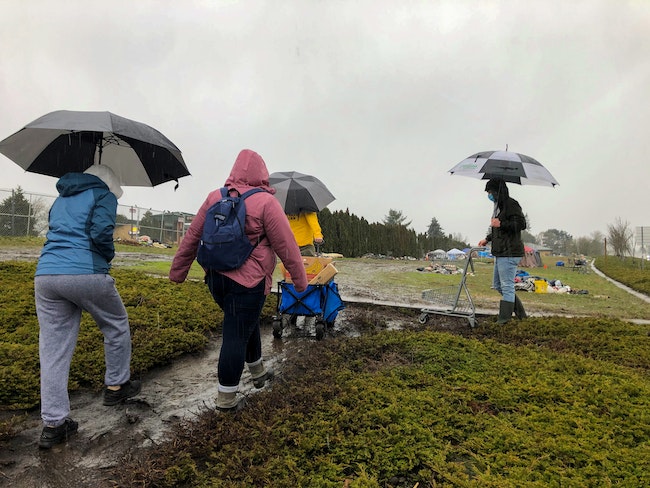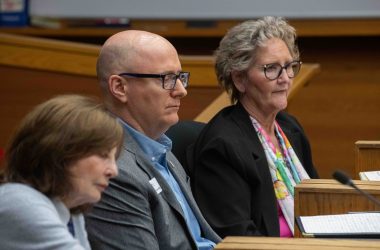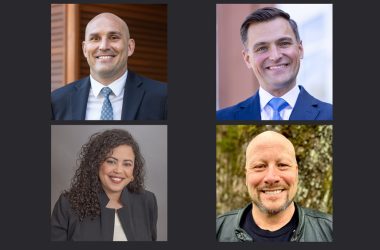
ARCHES staff walk into a field for the annual point in time count on Jan. 26, 2021. (Saphara Harrell/Salem Reporter)
Each month Jan Calvin looks at a screen where dozens of faces have tuned in to talk about how to better help people experiencing homelessness.
Calvin, a consultant for the Mid-Willamette Valley Homeless Alliance, said the Salem area hasn’t before had a place where dozens of social service providers and government and nonprofit leaders could get together to collaborate and improve the work they do.
Now they do: the Mid-Willamette Valley Homeless Alliance.
The alliance is the Marion and Polk county region’s continuum of care, approved by the federal Department of Housing and Urban Development in Dec. 2019. It’s a program that the federal government distributes funding for homeless services to.
Previously Marion and Polk counties were part of a larger continuum of care that had 26 other counties. Local leaders said the wide-range of needs and communities included made it more difficult to get federal money for local projects.
The alliance has already seen success in getting millions locally.
In the spring, it received a $5.5 million federal grant to create emergency shelter, pay for street outreach and rapidly rehouse people. In September, the alliance found out it was awarded $3.7 million to tackle youth homelessness.
One of the biggest changes because of the creation of the alliance is increased collaboration and data sharing.
Calvin said homelessness work has shifted from the old model of “I’ve got a client in front of me, I’ve got to help them,” to working off a system that identifies the most vulnerable people in the community and using a variety of resources to help them.
She said it also reduces trauma, so people don’t have to retell their story over and over.
For example, if someone walks into a service provider they can look them up in the system and see if they’ve been approved for housing in Salem or when an outreach worker last talked to them.
In February 2020, about a quarter of housing and homeless service providers locally used the system. Now more than 80% do.
“It puts everybody on the same sheet music,” said Chris Hoy, vice chair of the alliance and a Salem city councilor.
He said the alliance “brings us all together with a common purpose. We need to recognize it’s a regional issue and we need to have regional solutions.”
Jimmy Jones, executive director of the Mid-Willamette Valley Community Action Agency, said the system serves as a diagnostic tool that can help identify what someone’s barriers are.
When all the service providers use it, it makes the region more competitive for HUD funding, Jones said.
But he cautioned against having too high of expectations.
“It’s going to take years,” he said of the alliance’s goals.
According to June 2020 data, there are 1,188 people experiencing homelessness in the region, 120 of whom are families and 578 of whom have been chronically homeless.
The Marion/Polk region has a higher chronic homelessness rate than the state or nation, with 43% of people chronically homeless compared to 34% in Oregon and 27% nationwide.
Janet Carlson, a consultant with the alliance, pointed to the number of prisons in the area for one reason why the percentage might be higher. People leaving prison are at a higher risk for homelessness.
Continuum of care
In Marion and Polk counties, the continuum of care program was coordinated by the Mid-Willamette Valley Community Action Agency until 2011, when the region joined a larger group with 26 other Oregon counties.
The new alliance brings in more local decisionmakers.
Carlson said without strong governmental support they weren’t going to get action. Now, the group includes elected officials, not just those working in social services.
“You’ve got to have people that have authority to change the way services are delivered,” Carlson said.
She said people like Keizer Mayor Cathy Clark, Salem-Keizer School District Superintendent Christy Perry and Marion County Commissioner Colm Willis are all involved.
“That’s the thing that is making a big difference to have that level of people at the table enthused, excited,” she said.
She’s been giving presentations about the alliance’s work to all the groups involved, including Marion County, Polk County, Keizer, Salem, Marion County Health and Human Services, Community Action and the Confederated Tribes of Grand Ronde, to name a few.
Its mission, outlined in a strategic plan approved June 2020, is to develop an evidence-based system of services, including stable housing, designed to meet the unique and complex needs of adults, youth, children, and families in Marion and Polk counties who are at risk of or are experiencing homelessness.
Built for Zero
One example of how they’ve been trying to address homelessness is through a national initiative called Built for Zero.
The initiative has providers work together to develop a list of people who are experiencing homelessness and at high risk or need for housing. Providers meet several times a month to strategize about how to permanently house people on that list.
Carlson said the first person on that list was housed last October. Now, they’re starting to work through others, targeting people who have been chronically homeless and veterans.
Calvin said the approach is labor intensive because they’re trying to get quality information.
She said someone who’s chronically homeless has been on the street for a year or more or had three or four periods in the last three years where they were unsheltered, and also have a disability.
Correction: Keizer’s mayor is Cathy Clark, not Kathy. Salem Reporter regrets the error.
Contact reporter Saphara Harrell at 503-549-6250, [email protected].
JUST THE FACTS, FOR SALEM – We report on your community with care and depth, fairness and accuracy. Get local news that matters to you. Subscribe to Salem Reporter starting at $5 a month. Click I want to subscribe!









